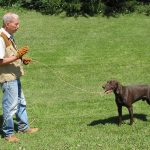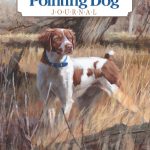One More Puppy
Transitioning from bird in the yard to thicker cover will help prepare the pup for those first forays in the woods.
And one more gun.
While I waited for Beverly to return home, I was thinking of Larry Potterfied’s ads where his wife walks in and asks, “How many guns does one man need?” while she was obviously wearing one of her 300 pairs of shoes. I have often been asked when is the right time to get another puppy. Of course, it depends on the individual, his or her age, age of his or her dogs, and the amount of hunting the individual plans to do in the next 10 years. Personally, I think the right time to get another puppy is when you want one, with need not being part of the reason. So at 77 years of age, I decided that although I have three adult dogs now, I wanted one more setter puppy.
I knew Beverly would not ask how many dogs I needed but instead she would say to get one. I told Beverly that if I was lucky and the Big Man had written at least 10 more chapters in my book of life, one more puppy would probably see me through. I explained it would take about two years to train her, and by that time, Tikki would be getting long in the tooth.
Most of our readers know that there is something magical about getting a new puppy. It seems to add more excitement and zest to our lives. For me, it even adds more purpose, feelings I believe are enhanced by age. The older I get, the more I look forward to each new season. And though I don’t like the fact that time is flying by, I also seem to want the opening of a new season to hurry. I think this comes from an inner feeling that I want it to get here because I’ll have this new puppy, and right now I know I will still be able to get out and follow the dogs. What I don’t know, and none of us do, is if we’ll be here for the next season.

Daisy Mae, the “grouse dog prospect.”
So along came Daisy Mae, a lovely little tri-colored setter. I got her from Jeff Angott, the same breeder where we got Tikki. From the beginning, I realized she might be something special, although a true bundle of energy. I am a firm believer that a puppy will let you know when she is ready for some elementary training to begin. First, there were the playful walks and runs in the open fields where Daisy showed she had an overabundance of energy and absolutely no fear of the brush and weeds. Then, at about six months, she started to be interested in everything that moved, from butterflies to grasshoppers. So I introduced her to pigeons.
I just let her smell them in a mesh bag where she could see and smell them. The first day or two, she was leery of the bag of birds but watched with great interest as I released them on the ground. In a day or two, she began to nuzzle the bird bag some and watched as the pigeons in the bag squirmed around. Once she was racing around the field trying to catch the flying pigeons, the gun was introduced. Making sure her only interest was the flying birds, the blank pistol was fired, producing no reaction at all from Daisy.
From there it was time to move the pigeons into launchers and place them in some easy cover for the pup to negotiate, always waiting for a morning with a decent breeze to give her every possible advantage in locating and winding the planted birds. As is often the case, the puppy ran by the planted birds the first couple of days. She was smelling them, but it hadn’t registered yet what she was smelling. Then, about the third or fourth time I worked her into the wind where we had a planted bird, and when still 10 yards away, she caught the pigeons’ scent and immediately froze in a stylish, head-and-tail-high point. It was clear:
Daisy Mae was on her way! I continued to work her in the open cover, planting birds in strips of milo, clumps of grass, and little patches of weeds, all the while working her into the birds on a checkcord.
If you are working with your first pointing dog, you want to surprise your puppy with the scent of the planted bird. By this I mean you don’t want to work the puppy directly into the wind and bird where the pup might hit the scent from 20 yards away; she’ll continue into the wind and scent because it is getting stronger the closer she works toward the planted bird. Instead, work the puppy across the wind where she will hit the scent all of a sudden, often causing an immediate stop when the scent strikes her brain and nose.
After only a few days of working Daisy on the checkcord, I was beginning to detect her desire to stand there rather than make a flash point and lunge in to flush the bird. At this point, the length of the checkcord was reduced to 10 feet. I knew now that I could get within eight to 10 feet before she showed any inclination to move closer. Of course, the dog has no idea how long the checkcord is but does know that she’s attached to it and realizes I still have some control over her movements. Three or four days of working with the short cord showed that I could actually get up to the dog without her taking a step.
It was now getting close to the time Rick and I would be leaving for an extended trip around the Lake States. Many believe a puppy at six or seven months is too young to put into wild birds, but I believe it all depends on the individual puppy. Some are ready at six months; others may not be ready for 18 months. In deciding if Daisy would be ready for her first trip for grouse and woodcock, I had my own criteria.
Then, about the third or fourth time I worked her into the wind where we had a planted bird… she caught the pigeons’ scent and immediately froze in a stylish, head-and-tail-high point.
First, she must show a desire to hunt. Second, she must show a desire to be with me and not running all over hell’s half-acre caring not at all where I am. Third, the puppy must show no fear of the birds or the gun. Fourth, she must not be afriad of cover because now she’s going to be taken from the open fields and placed in the thickets. I have seen some dogs, and owned a couple, that were probably put into the thickets before they were ready. A dog not ready, not having been introduced to the woods and only worked in the open cover, will often shut down and walk along with you, not knowing that there are birds in the woods because the only one they ever found was in open cover.
With this in mind, Daisy’s training was moved into the woods. If she hunted here, stayed with me, didn’t get lost, and found and held her birds, she would be ready. To my delight, she took to the woods as if doing it for months. She would be seven months old the 15th of October. Now I was confident that she was ready for the real thing, and I felt I had a promising grouse dog “prospect.” The real test was still to come.
There is one more segment to this saga. It goes back to Larry’s wife’s question of “how many guns does one man need,” and again, need is not to be considered here, only want. Many of us appreciate the great old, classic, American doubles, but I think this hits grouse hunters the hardest because we are tied together by our dogs and the King of Gamebirds, our beloved ruffed grouse. You see, many believe that it was our bird that created the classic doubles made by Parker, L.C. Smith, Fox, Ithaca, and Lefever. It was no accident that these companies developed in New England, as did grouse hunting. And following a beautiful setter or pointer and carrying one of these classic doubles takes us back to the beginning, makes us a part of the New England grouse covers described by William Harden Foster.

How many guns does one man need? Is it really a question of “need”?
So, did I need another classic double? Need had nothing to do with it when I saw a picture of a beautiful old 16-gauge L.C. Smith advertised in a local auction. I attended the auction and on inspection found this gun to be one of the prettiest, little used, original-condition doubles I have seen. To my surprise, the only bid on the double was an online bid.
None of the 200 attendees at the auction showed any interest at all in the gun. So when the auctioneer asked if anyone would bid $50 over the online bid, which was a very reasonable bid, I raised my hand, and the auctioneer said, “Sold to the man with the surprised look on his face!”
With a beautiful little, classic American double and a lovely little grouse dog prospect, I am ready for another season, results of which will be commented on later. For now, not that I really need it, I again have new purpose for my upland hunting journey.





